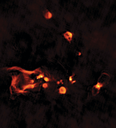Early Massive Star Formation
De Pree et al. present new Jansky Very Large Array (VLA) images of the central region of the W49A star-forming region at 3.6 cm and at 7 mm at resolutions of 0.15 arcsec (1650 AU) and 0.04 arcsec (440 AU), respectively. The 3.6 cm data reveal new morphological detail in the ultracompact H II region population, as well as several previously unknown and unresolved sources. In particular, source A shows elongated, edge-brightened bipolar lobes, indicative of a collimated outflow, and source E is resolved into three spherical components.
The authors also present VLA observations of radio recombination lines at 3.6 cm and 7 mm, and IRAM Northern Extended Millimeter Array (NOEMA) observations at 1.2 mm. Three of the smallest ultracompact H II regions (sources A, B2, and G2) all show broad kinematic linewidths, with ΔVFWHM ≳ 40 km s-1. A multi-line analysis indicates that broad linewidths remain after correcting for pressure broadening effects, suggesting the presence of supersonic flows. Substantial changes in linewidth over the 21 yr time baseline at both 3.6 cm and 7 mm are found for source G2. At 3.6 cm, the linewidth of G2 changed from 31.7 ± 1.8 km s-1 to 55.6 ± 2.7 km s-1, an increase of +23.9 ± 3.4 km s-1. The G2 source was previously reported to have shown a 3.6 cm continuum flux density decrease of 40% between 1994 and 2015. This source sits near the center of a very young bipolar outflow whose variability may have produced these changes.
Image Caption: VLA 3.6cm image at 0.15 arcsec resolution of W49A
Publication: C. G. De Pree (Agnes Scott College) et al., Time-variable Radio Recombination Line Emission in W49A, Astronomical Journal, 160, 234 (November 2020).
NRAO Press Release: IMAGE RELEASE: New Look at Bright Stellar Nursery





Connect with NRAO